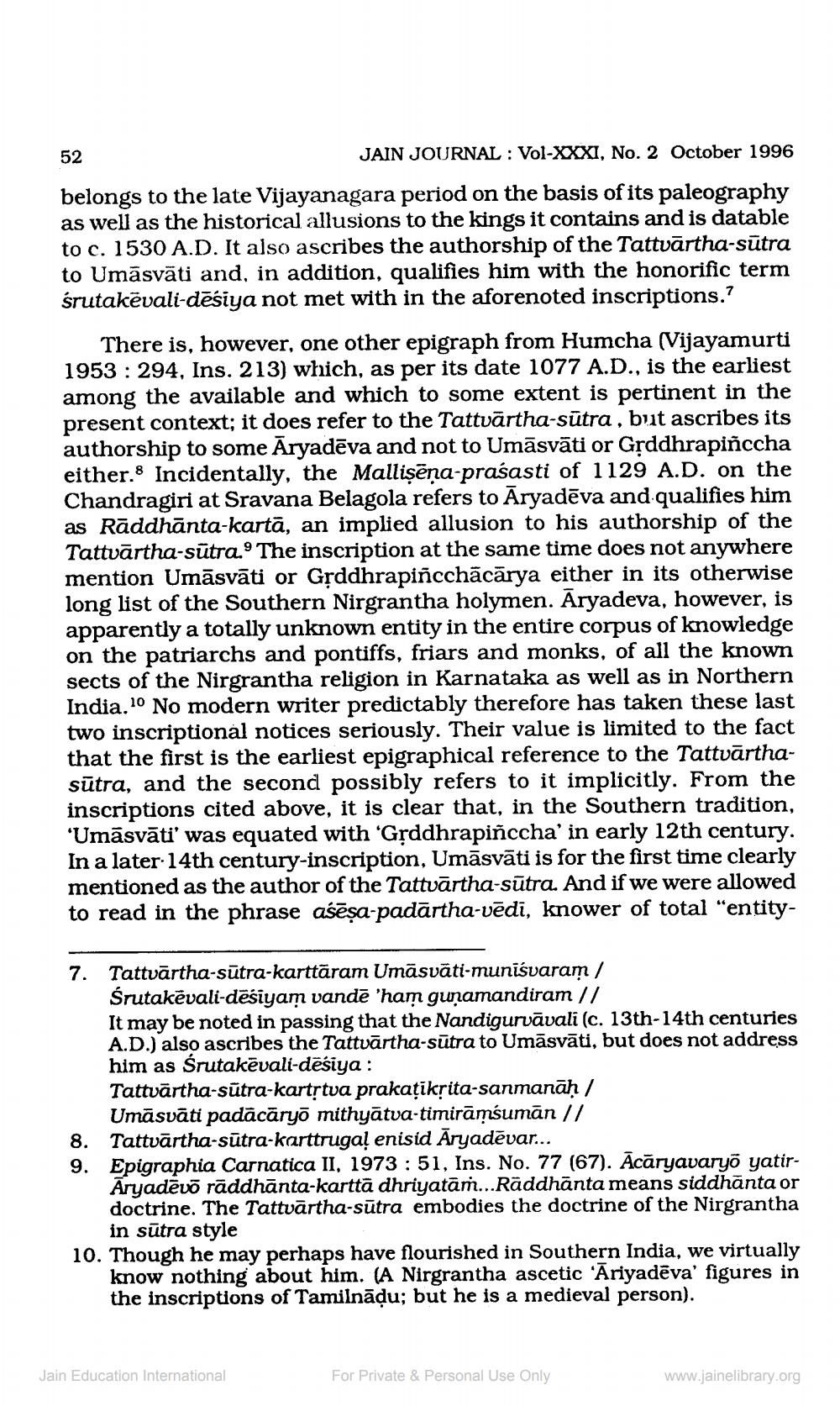________________
JAIN JOURNAL: Vol-XXXI, No. 2 October 1996
belongs to the late Vijayanagara period on the basis of its paleography as well as the historical allusions to the kings it contains and is datable to c. 1530 A.D. It also ascribes the authorship of the Tattvārtha-sūtra to Umāsväti and, in addition, qualifies him with the honorific term śrutakēvali-desiya not met with in the aforenoted inscriptions.7
52
There is, however, one other epigraph from Humcha (Vijayamurti 1953 294, Ins. 213) which, as per its date 1077 A.D., is the earliest among the available and which to some extent is pertinent in the present context; it does refer to the Tattvärtha-sūtra, but ascribes its authorship to some Aryadeva and not to Umāsväti or Gṛddhrapiñccha either. Incidentally, the Malliṣēņa-prasasti of 1129 A.D. on the Chandragiri at Sravana Belagola refers to Aryadeva and qualifies him as Rāddhanta-karta, an implied allusion to his authorship of the Tattvärtha-sutra.9 The inscription at the same time does not anywhere mention Umāsvāti or Gṛddhrapiñcchācārya either in its otherwise long list of the Southern Nirgrantha holymen. Aryadeva, however, is apparently a totally unknown entity in the entire corpus of knowledge on the patriarchs and pontiffs, friars and monks, of all the known sects of the Nirgrantha religion in Karnataka as well as in Northern India. 10 No modern writer predictably therefore has taken these last two inscriptional notices seriously. Their value is limited to the fact that the first is the earliest epigraphical reference to the Tattvārthasūtra, and the second possibly refers to it implicitly. From the inscriptions cited above, it is clear that, in the Southern tradition, 'Umāsvāti' was equated with 'Gṛddhrapiñccha' in early 12th century. In a later 14th century-inscription, Umāsvāti is for the first time clearly mentioned as the author of the Tattvārtha-sūtra. And if we were allowed to read in the phrase aseṣa-padartha-vēdi, knower of total "entity
7.
Tattvartha-sutra-karttaram Umäsväti-munisvaram/
Śrutakēvali-desiyam vandē 'ham guṇamandiram //
It may be noted in passing that the Nandigurvavali (c. 13th-14th centuries A.D.) also ascribes the Tattvartha-sutra to Umāsvāti, but does not address him as Śrutakēvali-dēsiya :
Tattvārtha-sūtra-kartṛtva prakaṭikṛita-sanmanāḥ/
Umāsvāti padācāryō mithyātva-timirāmsumān // 8. Tattvärtha-sutra-karttrugal enisid Aryadevar...
9. Epigraphia Carnatica II, 1973: 51, Ins. No. 77 (67). Acāryavaryō yatirAryadēvō rāddhanta-kartta dhriyatām...Räddhanta means siddhanta or doctrine. The Tattvärtha-sūtra embodies the doctrine of the Nirgrantha in sūtra style
10. Though he may perhaps have flourished in Southern India, we virtually know nothing about him. (A Nirgrantha ascetic 'Ariyadeva' figures in the inscriptions of Tamilnāḍu; but he is a medieval person).
Jain Education International
For Private & Personal Use Only
www.jainelibrary.org




